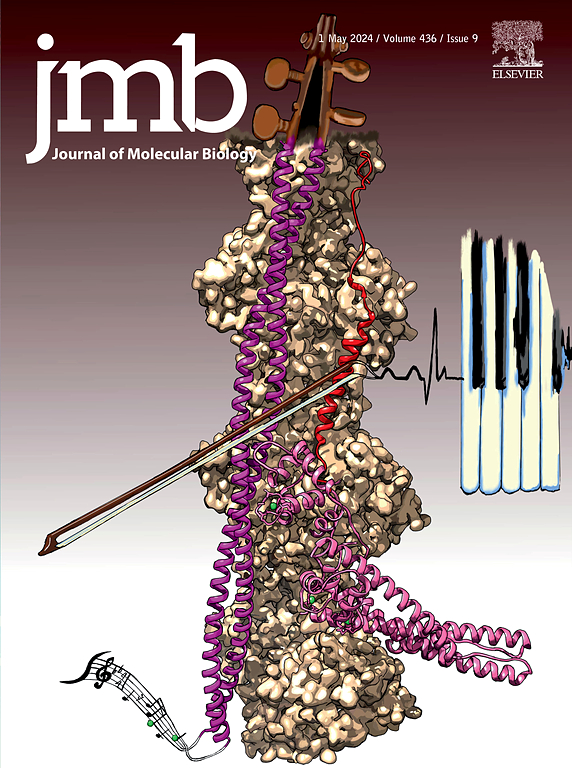组蛋白去甲基化酶KDM5A的内在紊乱区域通过与核小体酸性斑块和DNA的相互作用激活催化。
IF 4.5
2区 生物学
Q1 BIOCHEMISTRY & MOLECULAR BIOLOGY
引用次数: 0
摘要
赖氨酸去甲基酶5A (KDM5A)通过催化组蛋白H3K4 (H3K4me3)上三甲基标记的去除,在染色质可及性调控中起关键作用。KDM5A也是一种致癌驱动因子,在乳腺癌、肺癌和卵巢癌等多种癌症中均观察到KDM5A的过表达。过去的研究已经描述了KDM5A结构域的功能,包括KDM5A与组蛋白H3尾部的相互作用,但尚未确定驱动KDM5A与核小体结合的更广泛机制。通过研究核小体底物的结合和催化作用,我们发现KDM5A与H2A/H2B酸性斑块和DNA的多价相互作用在催化活性的调节中起关键作用。我们还发现了一个内在无序区(IDR),其中含有双功能的富含精氨酸的基序,能够结合组蛋白H2A/H2B酸性斑块和核小体DNA,这是核小体底物催化所必需的。我们的发现既阐明了以前未知的调节KDM5A催化活性的机制,也揭示了IDR参与与染色质多种相互作用的能力。本文章由计算机程序翻译,如有差异,请以英文原文为准。

An Intrinsically Disordered Region of Histone Demethylase KDM5A Activates Catalysis Through Interactions With the Nucleosomal Acidic Patch and DNA
Lysine demethylase 5A (KDM5A) plays a key role in the regulation of chromatin accessibility by catalyzing the removal of trimethyl marks on histone H3K4 (H3K4me3). KDM5A is also an oncogenic driver, with overexpression of KDM5A observed in various cancers, including breast, lung, and ovarian cancer. Past studies have characterized the functions of KDM5A domains, including KDM5A interactions with the histone H3 tail, but have yet to identify the broader mechanisms that drive KDM5A binding to the nucleosome. Through investigation of binding and catalysis on nucleosome substrates, we uncovered multivalent interactions of KDM5A with the H2A/H2B acidic patch and DNA that play crucial roles in the regulation of catalytic activity. We also identified an intrinsically disordered region (IDR) containing bifunctional arginine-rich motifs capable of binding to both the histone H2A/H2B acidic patch and nucleosomal DNA that is necessary for catalysis on nucleosome substrates. Our findings both elucidate previously unknown mechanisms that regulate KDM5A catalytic activity and reveal the ability of an IDR to engage in multiple interactions with chromatin.
求助全文
通过发布文献求助,成功后即可免费获取论文全文。
去求助
来源期刊

Journal of Molecular Biology
生物-生化与分子生物学
CiteScore
11.30
自引率
1.80%
发文量
412
审稿时长
28 days
期刊介绍:
Journal of Molecular Biology (JMB) provides high quality, comprehensive and broad coverage in all areas of molecular biology. The journal publishes original scientific research papers that provide mechanistic and functional insights and report a significant advance to the field. The journal encourages the submission of multidisciplinary studies that use complementary experimental and computational approaches to address challenging biological questions.
Research areas include but are not limited to: Biomolecular interactions, signaling networks, systems biology; Cell cycle, cell growth, cell differentiation; Cell death, autophagy; Cell signaling and regulation; Chemical biology; Computational biology, in combination with experimental studies; DNA replication, repair, and recombination; Development, regenerative biology, mechanistic and functional studies of stem cells; Epigenetics, chromatin structure and function; Gene expression; Membrane processes, cell surface proteins and cell-cell interactions; Methodological advances, both experimental and theoretical, including databases; Microbiology, virology, and interactions with the host or environment; Microbiota mechanistic and functional studies; Nuclear organization; Post-translational modifications, proteomics; Processing and function of biologically important macromolecules and complexes; Molecular basis of disease; RNA processing, structure and functions of non-coding RNAs, transcription; Sorting, spatiotemporal organization, trafficking; Structural biology; Synthetic biology; Translation, protein folding, chaperones, protein degradation and quality control.
 求助内容:
求助内容: 应助结果提醒方式:
应助结果提醒方式:


